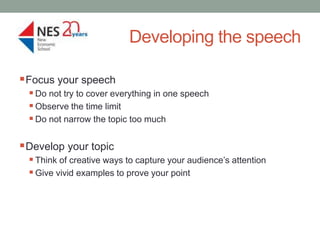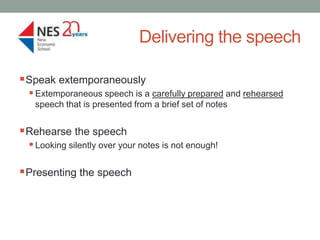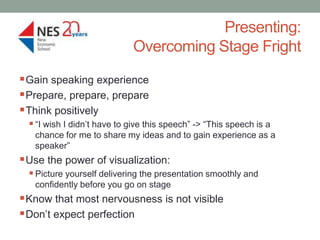Preparing your first speech
- 1. PREPARING YOUR FIRST SPEECH NES English Department Fall semester 2012 Anna Tsvetkova
- 2. Stages of preparation  Developing the speech  Organizing the speech  Delivering the speech
- 3. Developing the speech  Focus your speech  Do not try to cover everything in one speech  Observe the time limit  Do not narrow the topic too much  Develop your topic  Think of creative ways to capture your audience’s attention  Give vivid examples to prove your point
- 4. Organizing the speech  The classic three-part organization:  Introduction  Body  Conclusion
- 5. Organization: Introduction  Get the attention and interest of the audience  Pose a question  Tell a story  Make a startling statement  Begin with a quotation  Reveal the topic of your presentation
- 6. Organization: Body  Order the information  Follow a certain sequence: chronological, spatial, causal, problem- solution, topical  Single out your main points  Focus each point on one idea  Limit the number of points depending on the time  Use transitions  Transitions help the listener follow you
- 7. Organization: Conclusion  Let the audience know you are about to finish  Reinforce your central idea  If possible, end on a dramatic, clever, or thought- provoking note.
- 8. Organization: Conclusion  Let the audience know you are about to finish  Reinforce your central idea  If possible, end on a dramatic, clever, or thought- provoking note.
- 9. Delivering the speech  Speak extemporaneously  Extemporaneous speech is a carefully prepared and rehearsed speech that is presented from a brief set of notes  Rehearse the speech  Looking silently over your notes is not enough!  Presenting the speech
- 10. Presenting: start  Move to the front of the room  Face the audience  Assume a relaxed and upright posture  Plant your feet a bit less than shoulder-width apart  Allow your arms to hang loosely by your side  Arrange your notes before you start to speak  Take a moment to take a look over your audience  AND SMILE
- 11. Presenting: Gestures  Feel free to use your hands to gesture, but don’t plan your gestures ahead of time – move naturally  Avoid nervous mannerisms, such as twisting your hair, wringing your hands, shifting your weight from one foot to the other, rocking back and forth, tapping your fingers on the table  Try to appear calm and relaxed
- 12. Presenting: Eye Contact  Look at the audience as often as you can  Be sure to look to the left and right as well as to the center  Avoid the temptation to speak exclusively to one or two sympathetic individuals  If you are too nervous to look your classmates in the eye, look to the side of each person or just above his or her head
- 13. Presenting: Voice  Use your voice expressively  Speak loudly so as to reach the back of the room  Speak slowly, do not race through your speech
- 14. Presenting: Overcoming Stage Fright  Gain speaking experience  Prepare, prepare, prepare  Think positively  “I wish I didn’t have to give this speech” -> “This speech is a chance for me to share my ideas and to gain experience as a speaker”  Use the power of visualization:  Picture yourself delivering the presentation smoothly and confidently before you go on stage  Know that most nervousness is not visible  Don’t expect perfection
- 15. Source  Lucas, Stephen E. The Art of Public Speaking. 11th ed. New York: McGraw Hill, 2012. Pp 9-15, 63-75. Print.















